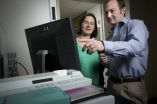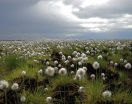(Press-News.org) DURHAM, N.C. -- Every year waste treatment facilities in the United States process more than eight million tons of semi-solid sewage called biosolids -- about half of which is recycled into fertilizer and spread on crop land.
The practice helps solve storage issues and produces revenue to support the treatment plants, but what else is being spread in that sludge?
As industry invents new materials and chemicals for modern products, many find their way to our skin and bloodstream and, subsequently, into our sinks and toilet bowls. More than 500 different organic chemicals have been identified in the biosolids used as fertilizer across the United States.
Federal law regulates remnant levels of heavy metals and pathogens in the biosolid fertilizer, but other chemicals are not currently accounted for because it has been prohibitively expensive to even begin sorting out which ones might be ecologically unfriendly, says Claudia Gunsch, professor of civil and environmental engineering at Duke University.
In a recent study, Gunsch and colleagues from Duke's Pratt School of Engineering describe a new, cost-effective method for screening chemicals for potential environmental impact. They have used the test to show that triclosan, an antimicrobial agent currently under fire from environmentalists, has troubling concentrations in the environment, and they raise suspicions about three other commonly used antimicrobial products.
The team describes their new testing method and some of its early findings in the Feb. 4 2014 Journal of Environmental Science & Technology.
"Because we're finding many emerging contaminants in biosolids, we wanted to develop a method where you could check them quickly and efficiently and flag the most potentially dangerous ones for more complex measurements," said Ryan Holzem, a graduate student in civil and environmental engineering at Duke and first author on the study.
An important benefit of fertilizing soil is replenishing nitrate levels, which are crucial to growing plants. One indicator of the soil's health is the rate at which native bacteria are breaking down those nitrates through a process called denitrification. If antimicrobials or other chemical agents are affecting the bacteria's ability to complete this process, the soil's quality is degraded.
The new screening technique involves growing a bacterium commonly found in soil that is important to the nitrogen cycle -- Paracoccus denitrificans -- in pure laboratory cultures. Researchers then add various amounts of the chemicals in question to determine the minimum amount that affects the denitrification process.
"We chose the nitrogen cycle as an indicator because we wanted to represent an environmental process that is critical to agriculture," Holzem said. "Typically you have to use a complex, $50,000 piece of equipment to measure the gasses that are produced by the active bacteria. But our method isolates denitrification on its own so that we can use simple processes to measure it."
To test the new screening technique, Holzem and Gunsch worked with Heather Stapleton, associate professor of civil and environmental engineering, to examine six commercial antimicrobial chemicals. Two are used in abundance: triclosan, which is found in most antibacterial soaps and toothpastes, and triclocarban, which isn't far behind in both uses and criticisms. They also looked at four emerging antimicrobial compounds used in applications such as pesticides, paper mills, deodorants and antimicrobial household goods.
"These chemicals are everywhere," said Gunsch. "Our society loves products that prevent microbial growth."
The Duke team found that environmental levels of triclosan should raise an immediate red flag, given its effects on the critical Paracoccus bacteria, and that three of the other five compounds tested are found in concentrations high enough to warrant concern.
The results showed not only that the technique works, but that it is more sensitive than laborious and more expensive testing methods involving measurements of gene expression and cell viability.
While the screening process only looked at the effects of six antimicrobial agents on one indicator of environmental health -- the nitrogen cycle -- Gunsch and Holzem say the technique could be used to test a variety of compounds through many different ecological indicators.
"We hope that companies developing new chemicals might use this method to start looking at potential environmental threats before incorporating them into consumer products," said Gunsch.
INFORMATION:
Their work was supported in part by the National Science foundation grant CBET-0854167.
CITATION: "Determining the Ecological Impacts of Organic Contaminants in Biosolids using a High-Throughput Colorimetric Denitrification Assay: A Case Study with Antimicrobial Agents," Holzem, R.M., Stapleton, H.M., Gunsch, C.K. Environmental Science and Technology, Feb. 4, 2014. DOI: 10.1021/es404431k
Screening wastewater biosolids for environmental contaminants
Simple, inexpensive method assesses environmental and agricultural effects of treated waste used as fertilizer
2014-02-14
ELSE PRESS RELEASES FROM THIS DATE:
Researchers find brain's 'sweet spot' for love in neurological patient
2014-02-14
A region deep inside the brain controls how quickly people make decisions about love, according to new research at the University of Chicago.
The finding, made in an examination of a 48-year-old man who suffered a stroke, provides the first causal clinical evidence that an area of the brain called the anterior insula "plays an instrumental role in love," said UChicago neuroscientist Stephanie Cacioppo, lead author of the study.
In an earlier paper that analyzed research on the topic, Cacioppo and colleagues defined love as "an intentional state for intense [and long-term] ...
Hot issues in climate change research to be debated at AAAS Annual Meeting
2014-02-14
CHICAGO—The "big issues" in climate change science have shifted over the past 4 to 6 years, with several difficult problems resolved while new research challenges rose to the fore. Scientists who are leading advisors on climate change to federal and international policymakers will examine the state-of-the-science in "Research Challenges in Climate Change: What's New and Where are We Going?" on Feb. 14 at the American Association for the Advancement of Science (AAAS) Annual Meeting in Chicago.
"The session will be very forward looking. What we would like to do better ...
Grape seed promise in fight against bowel cancer
2014-02-14
University of Adelaide research has shown for the first time that grape seed can aid the effectiveness of chemotherapy in killing colon cancer cells as well as reducing the chemotherapy's side effects.
Published in the prestigious journal PLOS ONE, the researchers say that combining grape seed extracts with chemotherapy has potential as a new approach for bowel cancer treatment – to both reduce intestinal damage commonly caused by cancer chemotherapy and to enhance its effect.
Lead author Dr Amy Cheah says there is a growing body of evidence about the antioxidant health ...
Optimizing donor kidney distribution in the United States
2014-02-14
Northwestern University's Sanjay Mehrotra has developed an innovative model that could help ease kidney distribution inequities among regions in the U.S. and ultimately help save hundreds of lives. His mathematical model, which takes into account a number of different factors, simulates and optimizes donor kidney distribution.
Mehrotra will discuss his research in a presentation titled "Addressing Allocation Inefficiencies and Geographic Disparities" at the American Association for the Advancement of Science (AAAS) annual meeting in Chicago. His presentation is part of ...
Early childhood education can pay big rewards to families, society
2014-02-14
High quality early childhood education for disadvantaged children can simultaneously reduce inequality and boost productivity in America, contends James Heckman, a professor of economics at the University of Chicago and one of the nation's leading experts on early childhood education.
"With the global rise in income inequality, children born into disadvantaged environments are at much greater risk of being unskilled and facing many obstacles in life - which is bad for individuals and bad for societies," said Heckman, who delivered a talk "Giving Kids a Fair Chance Early ...
Cancer doctors have opportunities to cut costs without risk to patients, experts say
2014-02-14
In a review article published Feb. 14 in The Lancet Oncology, Johns Hopkins experts identify three major sources of high cancer costs and argue that cancer doctors can likely reduce them without harm to patients. The cost-cutting proposals call for changes in routine clinical practice involved in end-of-life care, medical imaging and drug pricing.
"We need to find the best ways to manage costs effectively while maintaining the same, if not better, quality of life among our patients," says Thomas Smith, M.D., The Harry J. Duffey Family Professor of Palliative Medicine ...
University of Guelph study assesses environmental impact of Ontario corn production
2014-02-14
Researchers at the University of Guelph examined the energy use and greenhouse gas (GHG) emissions associated with corn production in Ontario. Their findings are published today in the Agricultural Institute of Canada's (AIC) Canadian Journal of Soil Science.
The study reports estimated county-level energy and GHG intensity of grain corn, stover and cob production in Ontario from 2006-2011. According to the paper's authors, most of the energy used during corn production comes from the use of natural gas and electricity during grain drying; the production and application ...
South African healthcare workers face greater risk for TB, HIV
2014-02-14
A large-scale survey of South African healthcare workers has revealed major gaps in workplace
protection against tuberculosis, HIV and hepatitis, according to a University of British
Columbia health researcher.
Presenting findings today at the 2014 annual meeting of the
American Association for the Advancement of Science (AAAS), Dr. Annalee Yassi says issues such
as confidentiality, stigma, technological capacity and staff training need to be addressed while
improving hospital resources and protocols.
Preliminary results of the 2012 baseline
survey ...
Survey: Americans struggle with science; respect scientists
2014-02-14
While most Americans could be a bit more knowledgeable in the ways of science, a majority are
interested in hearing about the latest scientific breakthroughs and think highly of scientists.
This is according to a survey of more than 2,200 people conducted by the National Science
Foundation, one that is conducted every two years and
is part of a report – Science and Engineering Indicators – that the National Science Board provides
to the president and Congress.
A Michigan State University faculty member served as lead author for the chapter in the
report that covers ...
New research reinforces danger of drinking alcohol while pregnant
2014-02-14
Women who drink alcohol at moderate or heavy levels in the early stages of their pregnancy might damage the growth and function of their placenta – the organ responsible for supplying everything that a developing infant needs until birth - research at The University of Manchester shows.
Placentas studied in a laboratory environment showed that drinking alcohol at moderate (2/3 standard drinks) to high (4-6 standard drinks) rates reduced the cell growth in a woman's placenta.
The research, published in the journal PLoS One and funded by the British Medical Association, ...
LAST 30 PRESS RELEASES:
Numbers in our sights affect how we perceive space
SIMJ announces global collaborative book project in commemoration of its 75th anniversary
Air pollution exposure and birth weight
Obstructive sleep apnea risk and mental health conditions among older adults
How talking slows eye movements behind the wheel
The Ceramic Society of Japan’s Oxoate Ceramics Research Association launches new international book project
Heart-brain connection: international study reveals the role of the vagus nerve in keeping the heart young
Researchers identify Rb1 as a predictive biomarker for a new therapeutic strategy in some breast cancers
Survey reveals ethical gaps slowing AI adoption in pediatric surgery
Stimulant ADHD medications work differently than thought
AI overestimates how smart people are, according to HSE economists
HSE researchers create genome-wide map of quadruplexes
Scientists boost cell "powerhouses" to burn more calories
Automatic label checking: The missing step in making reliable medical AI
Low daily alcohol intake linked to 50% heightened mouth cancer risk in India
American Meteorological Society announces Rick Spinrad as 2026 President-Elect
Biomass-based carbon capture spotlighted in newly released global climate webinar recording
Illuminating invisible nano pollutants: advanced bioimaging tracks the full journey of emerging nanoscale contaminants in living systems
How does age affect recovery from spinal cord injury?
Novel AI tool offers prognosis for patients with head and neck cancer
Fathers’ microplastic exposure tied to their children’s metabolic problems
Research validates laboratory model for studying high-grade serous ovarian cancer
SIR 2026 delivers transformative breakthroughs in minimally invasive medicine to improve patient care
Stem Cell Reports most downloaded papers of 2025 highlight the breadth and impact of stem cell research
Oxford-led study estimates NHS spends around 3% of its primary and secondary care budget on the health impacts of heat and cold in England
A researcher’s long quest leads to a smart composite breakthrough
Urban wild bees act as “microbial sensors” of city health.
New study finds where you live affects recovery after a hip fracture
Forecasting the impact of fully automated vehicle adoption on US road traffic injuries
Alcohol-related hospitalizations from 2016 to 2022
[Press-News.org] Screening wastewater biosolids for environmental contaminantsSimple, inexpensive method assesses environmental and agricultural effects of treated waste used as fertilizer




